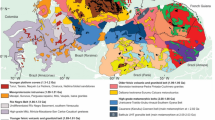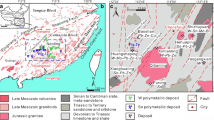Abstract
The discovery, at Kabbaldurga quarry, Karnataka, south India1–3, of patches of charnockite apparently in an arrested state of development has refocused attention on the mechanism of charnockite formation. In particular, the relative roles of CO2 and H2O during high grade metamorphism and charnockite development can be studied in such an area. During an influx of a CO2-rich volatile phase, H2O may be liberated as a result of the reduction in the state of hydration by the breakdown of hydrous minerals4. The P–T conditions in which this occurs are important because, with an increase in XH2O, conditions which may allow anatexis could be initiated in advance of such a CO2-rich phase. Indeed, Weaver5 has suggested that the K-rich acid charnockites found at Pallavaram, Madras6, developed due to changes in volatile composition before the onset of charnockite conditions. The exposure at Kabbaldurga quarry is interpreted here as displaying evidence that such a process has taken place.
Similar content being viewed by others
References
Pichamuthu, C. S. Nature 188, 135 (1960).
Ramiengar, A. S., Ramakrishnan, M. & Viswanatha, M. N. J. geol. Soc. Ind. 19, 411–419 (1978).
Janardhan, A. S., Newton, R. C. & Smith, J. V. Nature 278, 511–514 (1980).
Heier, K. S. Phil. Trans. R. Soc. A273, 429–442 (1973).
Weaver, B. L. Contr. Miner. Petrol. 71, 271–279 (1980).
Weaver, B. L., Tarney, J., Windley, B. F., Sungavaran, E. B. & Venkata Rao, V. in Archaean Geochemistry (eds Windley, B. F. & Naqvi, S. M.) 177–204 (Eisevier, Amsterdam, 1978).
Radhakrishna, B. P. Mysore geol. Ass. Bangalore Spec. Bull. 3, 1 (1956).
Crawford, A. R. J. geol. Soc. Ind. 10, 117–166 (1969).
Beckinsale, R. D., Drury, S. A. & Holt, R. W. Nature 283, 469–470 (1980).
Venkatasubramanian, V. S. & Narayanaswamy, R. J. Ind. Inst. Sci. 56, 19–42 (1974).
Divakara Rao, V., Aswathanarayana, U. & Qureshy, M. N. J. geol. Soc. Ind. 13, 1–12 (1972).
Divakara Rao, V., Aswathanarayana, U. & Qureshy, M. N. Mineral. Mag. 38, 678–686 (1972).
Streckeisen, A. L. Earth Sci. Rev. 12, 1 (1975).
Menhert, K. R. Migmatites and the Origin of Granitic Rocks (Elsevier, Amsterdam, 1968).
Brown, M. Proc. geol. Ass. 84, 371–382 (1973).
Quensel, P. Ark. Mineral. Geol. 1, 227–322 (1951).
Perkins, D. & Newton, R. C. Nature 292, 145–146 (1981).
Newton, R. C., Smith, J. V. & Windley, B. F. Nature 288, 45–49 (1980).
Schuiling, R. D. & Kreulen, R. Earth planet. Sci. Lett. 43, 298–302 (1979).
Author information
Authors and Affiliations
Rights and permissions
About this article
Cite this article
Friend, C. Charnockite and granite formation and influx of CO2 at Kabbaldurga. Nature 294, 550–552 (1981). https://doi.org/10.1038/294550a0
Received:
Accepted:
Issue Date:
DOI: https://doi.org/10.1038/294550a0
- Springer Nature Limited
This article is cited by
-
Orthophosphate and biotite chemistry from orthopyroxene-bearing migmatites from California and South India: The role of a fluid-phase in the evolution of granulite-facies migmatites
Mineralogy and Petrology (2009)
-
Diffusion-controlled biotite breakdown reaction textures at the solid/liquid transition in the continental crust
Contributions to Mineralogy and Petrology (2007)
-
Charnockitic magmatism in southern India
Journal of Earth System Science (2004)
-
Late Archaean crust-mantle interactions: geochemistry of LREE-enriched mantle derived magmas. Example of the Closepet batholith, southern India
Contributions to Mineralogy and Petrology (1995)
-
Response of zircon U?Pb isotopes and whole-rock geochemistry to CO2 fluid-induced granulite-facies metamorphism, Kabbaldurga, Karnataka, South India
Contributions to Mineralogy and Petrology (1992)





